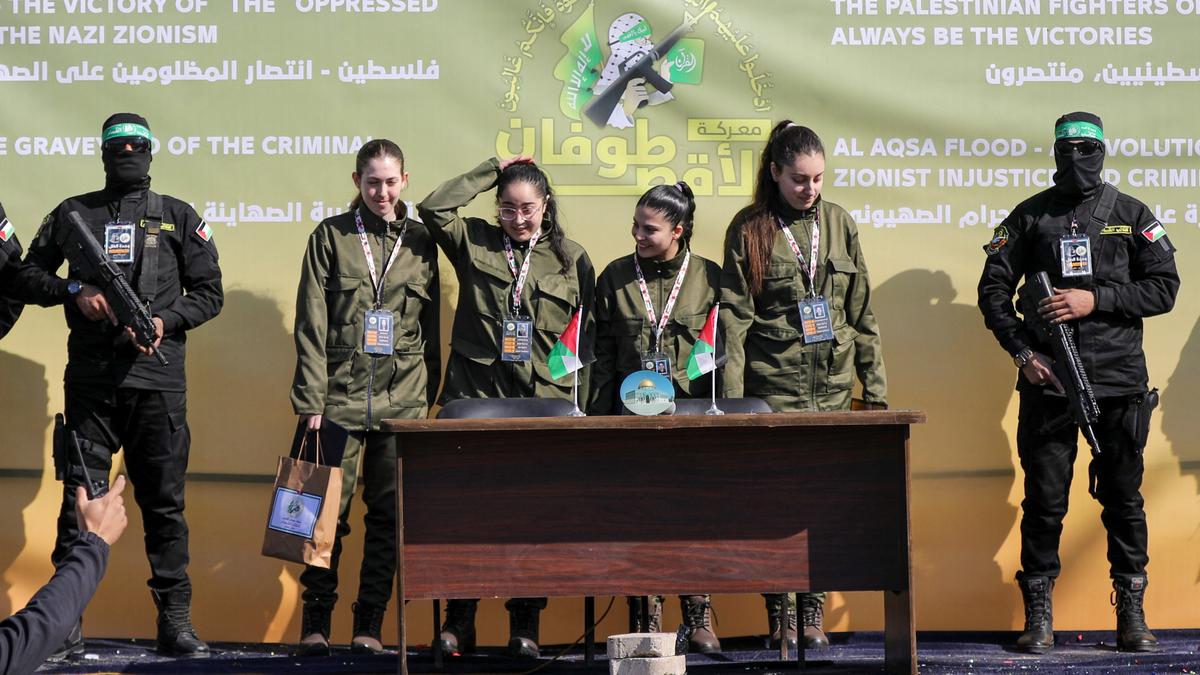Four Israeli Hostages Freed in Gaza Prisoner Exchange: A Historic Moment?
The world watched with bated breath as four Israeli women soldiers, held captive in Gaza for months, were finally released in a prisoner exchange, marking a significant turning point in the ongoing conflict. This dramatic event unfolded on January 25th, 2025, following a tense standoff and meticulous negotiations. The release was not just a symbolic victory but a testament to the complex geopolitical landscape and the difficult compromises required to achieve even fragile peace. What exactly happened? And what are the long-term implications of this historic swap?
The Captive Soldiers and Their Release
Karina Ariev, Daniella Gilboa, Naama Levy, and Liri Albag – four Israeli soldiers captured during the October 7, 2023, Hamas attack – spent agonizing months in captivity. Their plight became a symbol of the conflict, a stark reminder of the human cost of war. Their families endured unbearable uncertainty, with the images of their daughters in fatigues constantly flashed across the news. The public eagerly awaited news, leading to a flurry of online searches for updates using terms like "Israeli hostages Gaza release date" and "Gaza prisoner swap latest news." The event made international headlines, further fueling global concerns regarding conflict resolution and the handling of hostages in war zones. Their release was, understandably, met with a mix of relief and hope for all involved, even after days of rumors about prisoner releases and international efforts to secure a diplomatic outcome.
The Stages of the Release
The release wasn't instantaneous. First, Hamas announced the impending release on January 24th. A coordinated effort with the Red Cross was put into action. On January 25th, the soldiers were dramatically paraded on a stage in Gaza, before finally being transferred to the Red Cross representatives. The exchange included 200 Palestinian prisoners released by Israel. The prisoner swap is more than a single event; it’s part of an evolving series of actions undertaken over several months.
The Hamas-Israel Ceasefire Deal: A Delicate Balance
This prisoner exchange is deeply rooted in the fragile ceasefire agreement hammered out between Hamas and Israel, a deal brokered by Qatar and Egypt and backed by the United States. Negotiations for this agreement were painstaking and stretched over many months; after several attempted truces failed quickly. The ceasefire, still tentative, is structured in phases, with the first phase focusing on the release of a limited number of hostages for several waves of Palestinian prisoners, highlighting a complex prisoner swap mechanism used for dealing with the multiple fronts and various political goals. Searching online revealed common questions like "How long did the Gaza truce last?" and "What are the terms of the Gaza ceasefire agreement?"
Phased Approach to a Lasting Peace?
The agreement itself consists of stages, each dealing with a subset of the prisoner exchanges, adding complexity. The phased approach acknowledges the multitude of factors needing resolution and underscores the difficulty of bringing enduring peace to such a volatile and historic situation. Each subsequent phase will tackle additional challenges such as the exchange of remaining hostages and eventually, a long term and complicated discussion involving the full Israeli withdrawal from Gaza, leaving behind areas devastated by more than a year of fighting and bombing. Finding sustainable solutions requires political maneuvering and considerable international participation, resulting in extensive online debate, captured in search terms such as "Gaza conflict resolution strategy" and "long-term peace plan for Gaza."
Global Implications and Future Uncertainty
The release of these hostages wasn't just a regional event; it sent ripples across the globe. It underscored the delicate balance of power in the Middle East, the enduring complexities of conflict resolution, and the profound human toll of warfare. The event has inspired considerable analysis and commentary, with international experts offering varied interpretations.
Concerns Remain despite the Peace Accord
Even after a relative moment of peace achieved by the release of hostages, tensions remain high, raising concerns of another conflict quickly rising again. Future developments remain uncertain, given the fragility of the agreement. The long-term effects of the Gaza war will inevitably cast a long shadow, both in terms of humanitarian aid required and lingering mistrust. The search terms "Gaza reconstruction efforts" and "long-term impact of Gaza conflict" reveal widespread public concern on this subject.
Take Away Points
- The release of the four Israeli hostages is a landmark event within a larger conflict.
- The event represents only one stage of the ongoing negotiations. The conflict may require future concessions by either side.
- A complete lasting peace, though sought by all parties, remains far from certain, and is hampered by considerable past actions and lack of confidence by opposing parties.
- The international community will need to play a decisive role in brokering a more sustainable peace plan and aiding in rebuilding the damaged area of Gaza.









